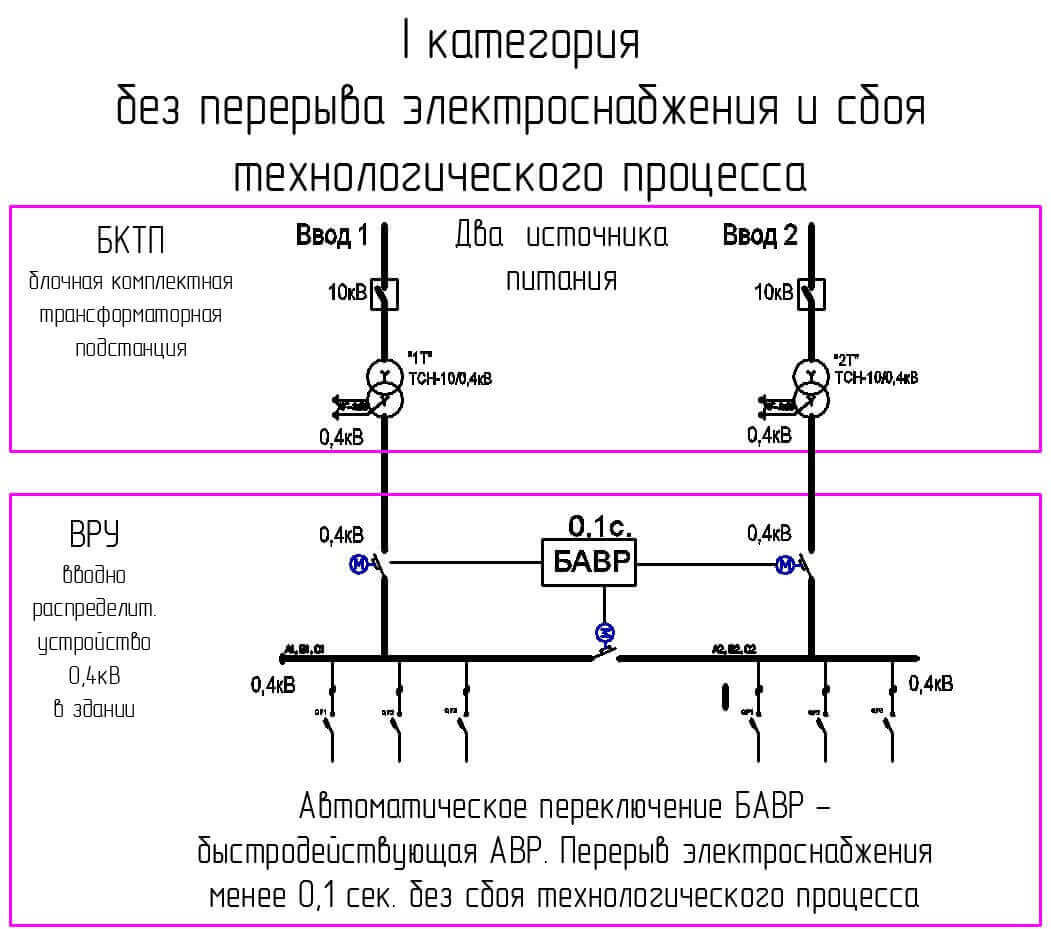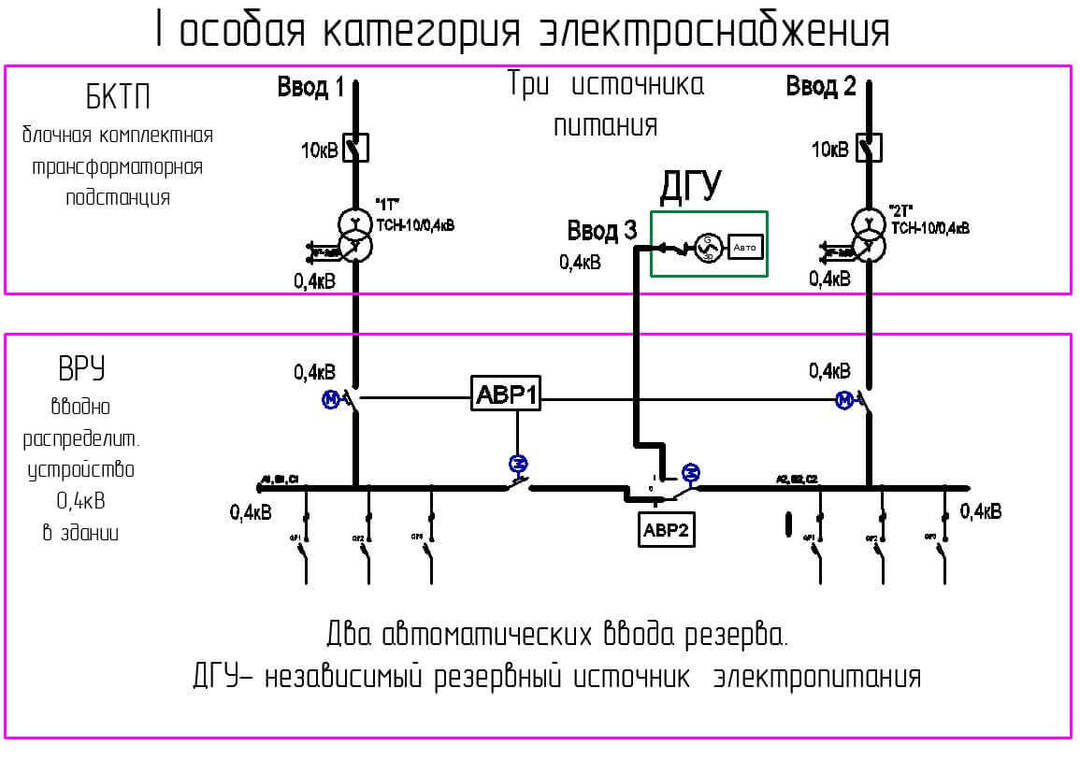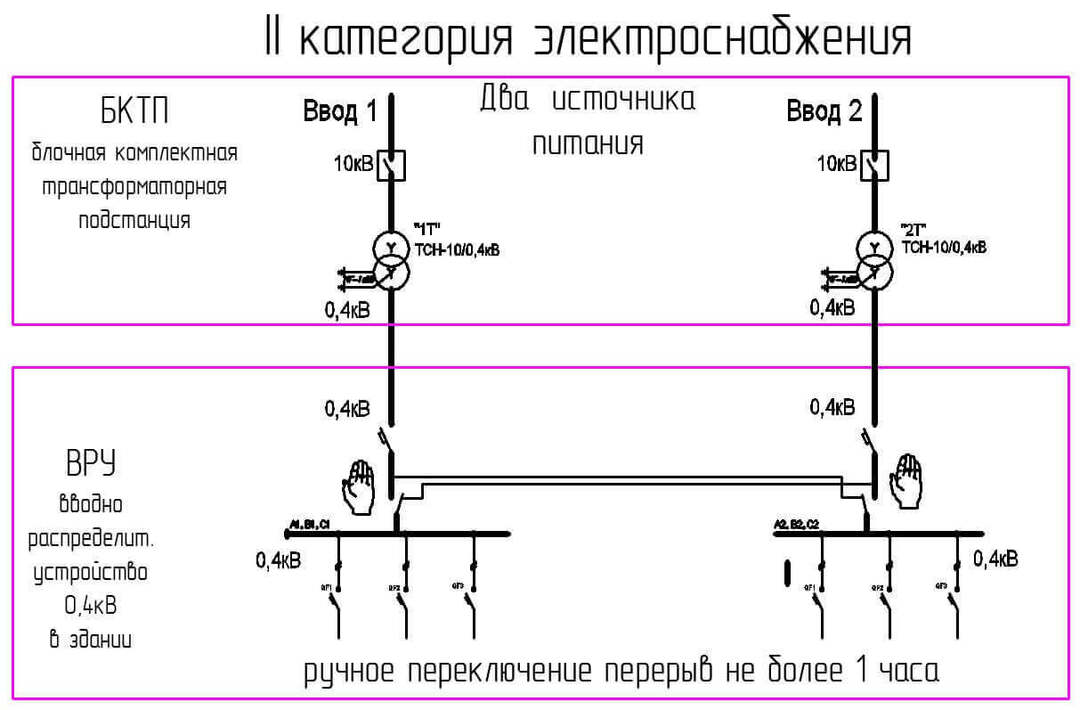Electrical Installation Rules (PUE-7) all electricity consumers are divided according to the reliability of the power supply. Consumers are conditionally divided into three categories of reliability, depending on the importance of the facility and the technological process. The categorization is determined at the design stage of the facility's power supply. The technological part of the project and regulatory documentation are taken as a basis. Briefly and in simple words, this concept can be rephrased as follows: “how reliable should power supply of industrial enterprises, so that its absence does not cause harm, taking into account possible factors? " Let's consider what are the categories of power supply reliability according to the PUE.
You can read this information in the PUE in chapter 1.2. by this link from the 17th point.
Content:
- First category
- Second category
- Third category
- Power outage and recovery times
- Conclusion
First category
The first category is especially important consumers, for whom a power outage can lead to:
- to the threat to human life;
- state security;
- the occurrence of a fire or explosion of an object;
- violation of the technological process, as a result of which significant material damage will be caused;
- the termination of the work of especially important objects of communal services, post offices, post offices and television.
These objects are:
- chemical, mining, clusters of production wells of oil and gas fields;
- foundries or drilling rigs;
- resuscitation departments, maternity hospitals and maternity wards, feldsher-obstetric stations, large dispensaries, etc .;
- boiler houses or central heating points, pumping stations of the first category, the work of which is associated with the life support of urban systems, water intake stations of pumping stations for water supply;
- traction substations for urban electric transport, Russian Railways;
- communication nodes (devices), cell towers and server rooms;
- control rooms of important city warning systems;
- fire alarm systems and fire protection devices;
- burglar alarm of objects with a large number of people;
- emergency lighting and emergency ventilation systems;
- elevators.
The enterprises are supplied with electricity from two independent power sources. The figure below shows the consumer connection diagram.

The power supply interruption time in this case is minimal. It is due to the response time of the automatic switching system, and should not exceed the standard of 0.5-0.7 seconds.
Especially hazardous enterprises can have a third independent power line, which increases reliability. Redundant lines must be in hot standby.
This means that they are constantly energized. If the capacity of the enterprise allows, then batteries or diesel generators are used as a backup source. Such a system is used when feeding bomb shelters, or in operating rooms.
The first category has a subsection of a specific consumer group. It is also called zero. Reliability of power supply, which is provided without fail by the third reserve source of electricity.
This is necessary for the trouble-free end of the production cycle to exclude the threat of fire, explosion and death of people. The figure below shows such a diagram of electrical receivers. Where a diesel generator is used as a third backup power source, for example, for sewage treatment plants.

Often the reserve is made from an independent source. In this case, the line is connected to the local power plant or, if the capacity permits, batteries are used.
Second category
The enterprises of the second group of reliability include enterprises or individual workshops, the shutdown of which threatens massive rejection of products, important urban structures, which will lead to the disruption of the main interconnected systems and cycles production. This is the most numerous class of consumers.
It includes such organizations:
- Kindergartens, schools and kindergartens (both ordinary and in rural areas), nurseries.
- Various medical organizations, hospitals, pharmacies and pharmacies.
- City institutions.
- Large shopping malls and sports facilities with a large crowd of people, for example, an ice palace.
- Objects resulting from a power outage can lead to an emergency or expose human life. These include street lighting, outdoor lighting for railroad crossings, obstruction lights when performing repair work, lighting hazardous sections of highways, parking lots, airport and etc.
- Gas boiler houses, gas metering units, pumping and pumping stations that do not belong to the first category.
All objects of the second category of reliability must be powered from two independent power sources. As shown in the diagram below.
The difference from the first is that a break in the supply of electricity is allowed according to PUE-7 up to two hours. This time is due to the work of the repair team. She must quickly leave and switch from one source to another.
All work is done manually. Thus, the time for switching electricity depends on the action of the operational duty officer or the mobile emergency team. Now diesel power plants are used as backup power.
It is advisable to use them where there are a large number of people. For example, for kindergarten, temple, school, theater, hotel. And also where material losses are possible, for example, refrigerators.
Third category
This type includes all enterprises and other power receiving devices that do not fall into the first and second categories.
It includes:
- Enterprises and city institutions, a power outage, which will not bring significant losses.
- Small settlements, dacha cooperatives, garages, cottage villages.
- Such reliability is suitable for individual housing construction, ABK, for a private house or for an apartment building.
All consumers are connected to one source of electricity. As shown in the diagram below.

Power outages are allowed for no more than 24 hours. This time is necessary for carrying out repair and restoration work by the emergency brigade.
Power outage and recovery times
The conditions for providing electricity are stipulated in the supply contract. It indicates the reliability of the system, the shutdown time per year and the time for repair work. These parameters are regulated by the PUE.
Consumers of the first and second categories of reliability determine the timing depending on the scheme of power grids and the availability of a backup power source. However, they should not exceed the norms provided for consumers of the third category.
For them, a one-time power outage should not exceed 24 hours. At the same time, the annual shutdown is also regulated. It is 72 hours.
Conclusion
The distribution of consumers by categories allows at the design stage, allows to optimize electrical networks. Create the most simple power system with maximum reliability and efficiency. Moreover, it must be easy to operate and maintainable.
The networks are built in such a way that in the event of an emergency or a shortage of electricity, the automation switches off consumers of the third category. And with a greater deficit, the second group is also disconnected. That allows you to avoid man-made accidents, entailing destruction, fires, material losses and loss of life.
Related materials:
- What are the tolerance groups for electrical safety
- The main reasons for power outages
- How to organize temporary power supply at a construction site
